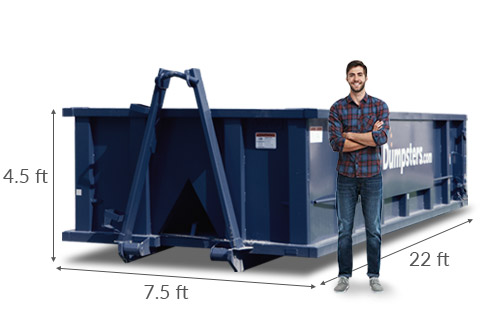When it involves dumpster rentals, a well-planned technique is essential to guarantee a hassle-free experience. Beginning by establishing your waste disposal needs, categorizing waste, and estimating the required dumpster size Choose the right dumpster dimension, varying from 10 to 40 cubic backyards, to prevent added rental prices or wasted space. Comprehend the rental period options, from 7 to 14 days, and plan for shipment by clearing the site and verifying needed permits. Fill up the dumpster securely by filling heavy things first and following safety guidelines By complying with these steps, you'll be well on your way to an effective dumpster rental experience; currently, find exactly how to tackle the remaining actions to ensure a smooth project.
Determining Your Garbage disposal Needs
When identifying your waste disposal needs, consider the kind and quantity of products to be discarded.
Separate waste right into classifications, such as building particles, household garbage, and recyclables. This segregation helps estimate the needed dumpster dimension and rental duration.
Additionally, think of the project's timeline, consisting of the begin and end dates, to ensure the dumpster is provided and grabbed accordingly.
Choosing the Right Dumpster Size
Accurate evaluation of waste disposal needs naturally causes the inquiry of what size dumpster is needed to suit the segregated waste. The ideal dumpster size is essential to ensure efficient waste management and stay clear of extra costs.

Dumpster sizes vary, generally ranging from 10 to 40 cubic lawns. A 10-yard dumpster, ideal for tiny projects, can hold about 2-3 pickup truck lots of waste. A 20-yard dumpster, perfect for medium-sized projects, can hold around 4-6 pickup truck loads.
Larger dumpsters, such as 30- and 40-yard systems, are much better matched for large-scale projects and can hold 8-12 pickup loads or more.
When choosing a dumpster dimension, consider the kind and volume of waste, as well as the offered room for the dumpster at your job site. It's vital to select a dimension that can suit your waste disposal requires without being as well little or as well large.
A dumpster that's also little might call for several rentals, including in the overall cost, while a dumpster that's also huge may cause thrown away area and unnecessary expenses.
Understanding Rental Duration Options
With the best dumpster size in position, interest transforms to the rental period, a significant element of waste management that can considerably impact job timelines and budgets.
The rental duration figures out the length of time you'll have the dumpster on-site, and picking the right period is important to staying on schedule and within budget.
Understanding your rental period choices is very important to a successful waste management plan. Below are 4 crucial considerations:
Standard Rental Periods: Most dumpster rental companies use common leasing durations, usually varying from 7 to 14 days.
Short-Term Rentals: If you require a dumpster for a shorter period, some business supply everyday or once a week rentals.
Long-Term Rentals: For bigger tasks or ongoing building, lasting rentals (as much as several months) might be necessary.
Flexible Rental Periods: Some firms provide flexible leasing durations, permitting you to change the duration as needed.
Preparing for Dumpster Delivery
Having safeguarded the excellent dumpster size and rental period, interest now moves to guaranteeing a smooth delivery process This involves preparing the distribution website to fit the dumpster, ensuring a hassle-free experience for both you and the delivery team.
Begin by removing the area where the dumpster will be put, getting rid of any type of challenges or debris that could prevent distribution. Guarantee the surface area is level and firm, as uneven or soft ground can cause the dumpster to shift or come to be unstable.
If the dumpster will be placed on a driveway or road, check with regional authorities to obtain any type of necessary permits or authorizations. In addition, note the distribution location with clear signage or cones to lead the distribution team and protect against any confusion.
Filling the Dumpster Safely
Properly loading a dumpster is vital to assure a successful waste monitoring project. This important step guarantees that you take full advantage of the dumpster's capability while maintaining safety and avoiding prospective issues.
To fill up the dumpster securely and successfully, follow these guidelines:
Load hefty items first: Place hefty materials like building and construction debris, furnishings, and appliances at the bottom of the dumpster to avoid lighter things from obtaining crushed.
https://piedmonttriad-dumpsters-64.mystrikingly.com/Fill in layers: Arrange waste right into layers, dividing different sorts of materials to avoid mixing and contamination.
Avoid overfilling: Leave adequate room to permit very easy disposal and transport; overfilling can cause security hazards and added fees.
Keep restricted items out: Refrain from getting rid of unsafe products, electronic devices, and various other banned things to avoid environmental damage and legal issues.
Managing Unforeseen Issues
Despite careful preparation, unexpected issues can still arise during a dumpster rental project It's essential to be prepared and recognize just how to take care of these unforeseen problems.
One usual problem is the dumpster being delivered to the wrong area or at the incorrect time. To avoid this, confirm the delivery details with the rental firm and validate a person exists to receive the dumpster.
Another possible concern is the dumpster being also little or also huge for the task. Be prepared to readjust your rental size or period if needed.
Additionally, inclement weather can trigger problems, such as making it tough to access the dumpster. Have a plan in position for alternate disposal methods if needed.
Finally, recognize any type of local regulations or constraints that might impact your dumpster leasing. By being gotten ready for these prospective problems, you can decrease delays and ensure a successful project
Remember to stay calm, communicate effectively with the rental company, and be adaptable to get over any type of unanticipated challenges that may arise.
